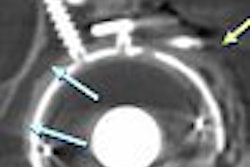Each of us has our own standards for our professional lives that are based on what we, individually, know. Legal standards, by contrast, can set the bar at any reasonable height simply by virtue of the fact that the information on the standard is available for you to find (and not necessarily in your head already). Unlike the incremental nudges by which legal standards usually change, the most recent publication on MRI patient safety has flung the standard ahead, but not only for referring physicians and radiologists.
The new American College of Radiology (ACR) "Guidance Document for Safe MR Practices: 2007," published online by both the American College of Radiology and the American Journal of Roentgenology (AJR), changes the defined standards for MR safety for far more than radiologists. Though there is extensive information on clinical risks and responses, from scanning pregnant patients to the use of gadolinium MR contrast media, the new document also raises the bar for administrative, technical, and design practices, as well for their roles in protecting patient safety.
One of the very first statements in the ACR document is that facilities are to appoint an MR safety officer, an individual to take charge of safety issues at that site. While it is every clinician's and technologist's duty to uphold safety principles, when responsibility for safety is delegated outward to the extreme ends, we then rely on each individual to practice safety effectively and in concert with the individual practices of others to achieve the overall goals of the site.
This "democratization" of safety standards runs contrary to the unified legal thresholds to which all providers are bound, and may wind up placing patients at unnecessary risk. By assigning oversight of safety principles to a single safety officer it is believed to be far more effective at addressing the multiplicity of safety concerns than is achieved by the ad hoc distributed approach typical of many MR providers.
Technologists, as the individuals with the lion's share of direct patient contact, also have enhanced expectations under the new document's standards. From insuring patient privacy during clinical screening to awareness of how best to remove a patient with a discovered unknown or contraindicated implant from the magnetic field, the new document identifies a number of practice changes or enhancements.
Perhaps most surprising is how far outside of the realm of immediate clinical practice the ripples of this new standard extend in the interest of protecting the safety of MR patients and personnel. Because of the inclusion of new physical design standards, the new guidance document has simultaneously elevated the clinical "standard of care" and the design world's "standard of practice" (though the latter lags a bit due to the natural delay in turning designs into bricks and mortar). Given the absence of design standards prior to the release of this document, MRI providers should work to ensure that their architects, engineers, and equipment planners devote extra levels of attention to the new standards to which they must be held.
The most direct indicator of these new extra clinical standards is the new appendix to the guidance document which offers standards that address safety planning principles that have historically escaped building codes and the guidance provided by MRI equipment vendors. For example, some of the new guidelines walk the reader through the functional divisions typified by the four-zone safety and screening principles, while others seek to unify varying safety design principles among the different vendors for cryogen safety.
Amid all of this change, one fact should emerge prominently: this one document has changed the legal landscape for nearly everyone who works in support of MRI equipment and the care it provides. Those who adapt and incorporate its teachings will be in harmony with the updated legal standards it presents. Those who fail to implement the identified guidance, even out of ignorance, are likely to put patients and staff at greater physical risk and, as a consequence, put themselves in an increasingly perilous legal position.
The new guidance document has been made available for free downloading on the Internet from both the AJR and ACR Web sites, dissolving any barriers that might otherwise hinder its dissemination. In the absence of any other competing standards for MR safety and with global access to the text of the guidance document, this single publication has drawn together clinical, operational, and facility factors to MR safety into a unified standard that defines the legal expectation of safety in the MR suite for clinicians and their design professionals.
On a personal note, I have been proud to represent MRI-Planning as a member of the special ACR MR safety committee that developed these standards. Our organization's support of my service on this committee further illustrates the fact that the promotion of safety within the MR environment has been, and continues to be, one of the driving principles of MRI-Planning.
By Tobias Gilk
AuntMinnie.com contributing writer
May 10, 2007
Reprinted from www.mri-planning.com by permission of the authors. If you would like more information on any aspect of MR facility design or safety, please contact Robert Junk or Tobias Gilk at MRI-Planning.com.
Related Reading
MRI and patient safety: Still waiting to go global, April 24, 2007
An open letter to MRI equipment vendors, April 12, 2007
MR suite level designations: Don't let complex procedures overwhelm your facility, March 27, 2007
How to calculate your MRI suite safety score, February 8, 2007
MRI risk isn't standing still -- are you? January 29, 2007
It's 300 gauss: Do you know where your vent is? December 29, 2006
Copyright © 2007 MRI-Planning



.fFmgij6Hin.png?auto=compress%2Cformat&fit=crop&h=100&q=70&w=100)




.fFmgij6Hin.png?auto=compress%2Cformat&fit=crop&h=167&q=70&w=250)











